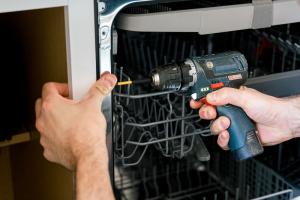Step-by-Step Guide to Installing a New Dishwasher Like a Pro

-
Quick Links:
- Introduction
- Tools You Will Need
- Preparation Before Installation
- Removing the Old Dishwasher
- Installing Your New Dishwasher
- Connecting the Water Supply
- Connecting the Electricity
- Testing Your Dishwasher
- Maintenance Tips for Your Dishwasher
- Conclusion
- FAQs
Introduction
Installing a new dishwasher can seem like a daunting task, but with the right tools and a step-by-step approach, it can be manageable and even rewarding. Dishwashers are essential kitchen appliances that save time and effort in maintaining cleanliness. This guide will walk you through the entire process, ensuring you can install your new appliance with confidence.
Tools You Will Need
Before you start your installation, gather the following tools:
- Adjustable wrench
- Screwdriver (Phillips and flathead)
- Pliers
- Drill
- Level
- Tape measure
- Bucket or towel (for spills)
- Utility knife
Preparation Before Installation
Preparation is key to a successful installation. Follow these steps:
- Measure your space to ensure the new dishwasher fits.
- Check the water supply and electrical outlets.
- Review the manufacturer’s installation manual for specific requirements.
Removing the Old Dishwasher
Before you install the new dishwasher, you will need to remove the old one:
- Turn off the power supply to the dishwasher.
- Disconnect the water supply line.
- Remove the drain hose from the sink or garbage disposal.
- Unscrew the mounting brackets that hold the dishwasher in place.
- Carefully slide the old dishwasher out of its cavity.
Installing Your New Dishwasher
Once the old unit is removed, it's time to install the new one:
- Position the new dishwasher in the cabinet space.
- Ensure it is level using the level tool.
- Secure the dishwasher to the countertop or cabinets using mounting brackets.
Connecting the Water Supply
Connecting the water supply is crucial for your dishwasher to function properly:
- Locate the water inlet valve on the dishwasher.
- Attach the water supply line and tighten it with an adjustable wrench.
- Turn on the water supply and check for leaks.
Connecting the Electricity
Next, you need to connect the dishwasher to the power supply:
- Locate the electrical junction box on the dishwasher.
- Follow the manufacturer’s instructions to connect the wires.
- Secure the junction box cover and restore power to the circuit.
Testing Your Dishwasher
After installation, it’s important to test the dishwasher:
- Run a short cycle to ensure all components are working properly.
- Check for leaks around the water supply and drainage areas.
- Ensure the door seals properly and there are no unusual noises.
Maintenance Tips for Your Dishwasher
To keep your dishwasher running efficiently, consider the following maintenance tips:
- Clean the filter regularly to avoid clogs.
- Run a cleaning cycle with vinegar monthly.
- Inspect hoses for wear and tear and replace if necessary.
Conclusion
Installing a new dishwasher may seem overwhelming, but with the right tools and knowledge, it can be a straightforward process. By following this guide, you can ensure that your new appliance is installed correctly and efficiently. Enjoy the convenience of a modern dishwasher!
FAQs
1. How long does it take to install a dishwasher?
Typically, it takes about 1-3 hours to install a dishwasher, depending on your plumbing and electrical setup.
2. Do I need a plumber to install my dishwasher?
While many homeowners can install a dishwasher themselves, hiring a plumber can ensure that the connections are secure and compliant with local codes.
3. Can I install a dishwasher without existing plumbing?
It is possible, but it requires professional help to create the necessary plumbing connections.
4. What should I do if my dishwasher leaks?
Check all connections for tightness and inspect hoses for damage. If the problem persists, consult a professional.
5. How do I know if my dishwasher is level?
Use a level tool to check that the dishwasher is even from front to back and side to side.
6. What if my new dishwasher doesn’t fit?
If it doesn’t fit, you may need to adjust the cabinetry or consult the manufacturer for recommendations.
7. Can I use any dishwasher in my kitchen?
It’s important to choose a dishwasher that fits your space and meets your plumbing and electrical specifications.
8. How often should I clean my dishwasher?
It’s advisable to clean the filter and run a cleaning cycle monthly to keep your dishwasher in optimal condition.
9. Is it safe to install a dishwasher myself?
Yes, as long as you follow safety protocols and the manufacturer's instructions. If unsure, consult a professional.
10. What are the signs that my dishwasher needs repair?
Common signs include strange noises, leaks, dishes not getting clean, or error codes displayed on the control panel.
Random Reads
- How to remove rusted screws
- How to remove mold and mildew
- How to remove mold from bags
- How to reset frigidaire dishwasher
- How to make mp3 or wav out of midi using audacity
- How to scan on your mac
- How to scan documents with an iphone
- How to install outdoor electric wiring
- How to install new stair treads
- Mastering the art of adding download links